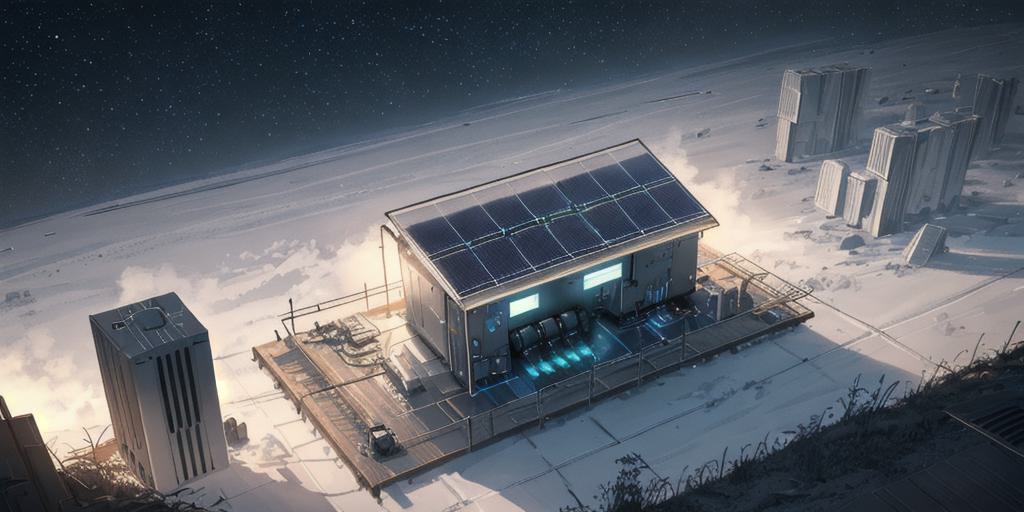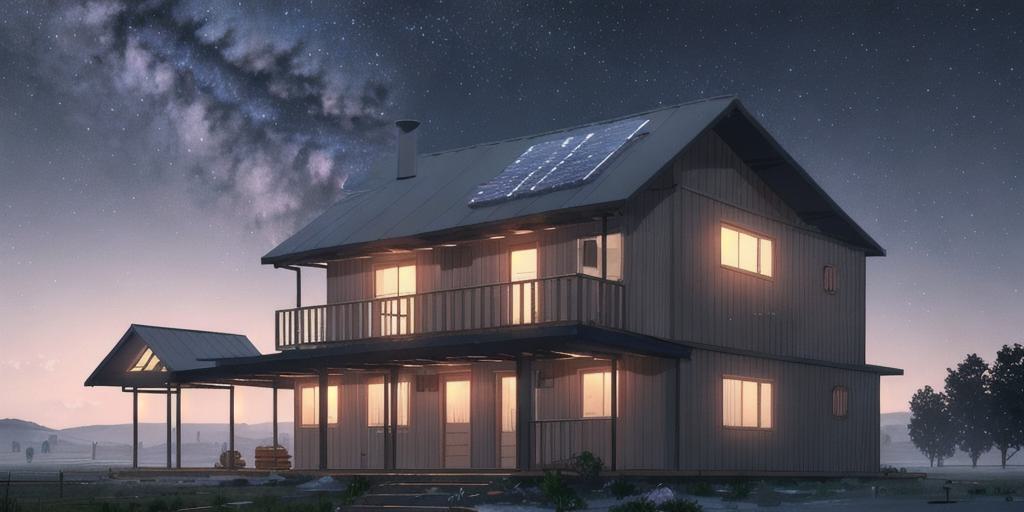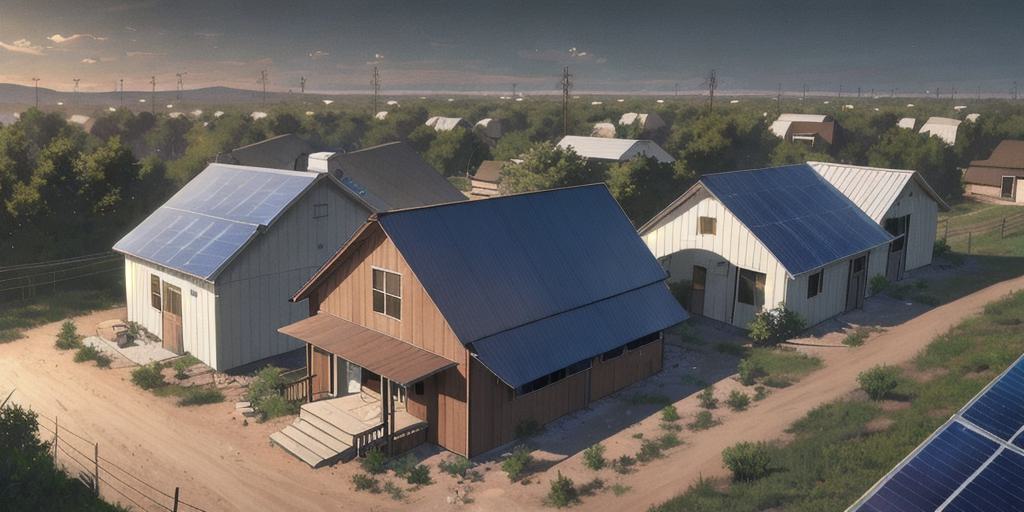Off-grid living is a powerful step towards independence, sustainability, and a more in-tune lifestyle with nature. The sun, wind, water, earth’s heat, biomass, wood pellets, fuel cells, and even the power grid itself can all be harnessed to create a comfortable, modern living experience outside of the 9-5 grind. Not only does off-grid living offer potential financial freedom, but it also provides an opportunity to reduce your carbon footprint and make a positive impact on the environment.
Choosing the right off-grid power solution depends on various factors: your location, available resources, budget, and personal preferences. Solar power is the most popular choice due to its accessibility and efficiency. However, wind and hydroelectric power also offer significant potential, particularly in regions with suitable conditions. Biomass power, wood pellet power, and fuel cells present exciting opportunities for turning waste into energy, while geothermal power taps into the Earth’s internal heat. Finally, grid-tie systems and community solar projects offer innovative ways to balance independence with connection, blending the benefits of off-grid living with the practicalities of on-grid connections.
- Solar power offers a multifaceted energy solution with potential for a slower, healthier, and more sustainable lifestyle.
- Wind power is a potent source of electricity, providing a renewable and a beacon of hope in our quest for energy independence.
- Hydroelectric power taps into the dynamic energy of moving water, offering a stable source of electricity.
- Geothermal energy offers a path towards energy independence, enabling us to live closer to nature while still enjoying the conveniences of modern life.
- Biomass energy converts waste into usable energy, providing a sustainable alternative to traditional energy sources.
- Wood pellet power offers a renewable and efficient source of heat.
- Small-scale hydroelectric power allows us to harness the power of nature to meet our energy needs efficiently.
- Fuel cells represent a new way of thinking about our relationship with energy and the environment.
- Grid-tie systems are a stepping stone on the path to a more sustainable, self-sufficient future.
- Community solar projects tap into local resources, spreading the initial costs of setup and maintenance across multiple participants, making solar power more accessible and affordable.
Solar Power: The Most Popular Off-Grid Option

Embracing the Sun: Harnessing Nature’s Abundant Energy Source
When it comes to off-grid living, the sun is your best friend. Not only does it dictate the rhythm of life, but it also offers an abundant, ever-present source of power. Solar power is a beacon of hope for those seeking independence from the 9-5 grind, offering the potential for a slower, healthier, and more sustainable lifestyle. Its benefits stretch beyond the environmental impact, reaching into the very core of financial freedom and personal autonomy.
But how efficient is solar power? Well, as this insightful article suggests, solar panels are not only effective in generating electricity but also in providing heat and supporting air conditioning systems. This is a multifaceted energy solution for those who wish to live off-grid, yet still enjoy the comforts of modern living.
The Power of Choice: Solar Power Kits
One of the most accessible ways to harness solar power is through solar power kits. These kits provide all the components needed to convert sunlight into usable electricity for your home. They can range from small setups powering a single appliance, to larger arrangements that can run an entire household.
Choosing the right solar power kit for your needs can be a bit of a journey. But as this resource suggests, it comes down to understanding your energy needs, the climate in your area, your budget, and your willingness to invest time in the installation process. With the right solar power kit, you can not only reduce your carbon footprint but also your monthly bills.
Pay-as-you-go Solar: A Revolution in Energy Financing
Solar power, despite its many advantages, can have a high upfront cost. This has often been a barrier for those wishing to move towards a more self-reliant lifestyle. But imagine if you could pay for your solar power in the same way you pay for your cell phone usage?
This article discusses Simpa Networks, a company that offers pay-as-you-go solar power systems in India. Customers pay a one-time fee for the hardware, then purchase increments of power as they need it. Over time, the customer owns the system outright and can use the solar power for free. This approach brings solar power within reach of even the most budget-conscious households.
Solar power isn’t just an energy solution, it’s a lifestyle transformation. It can offer a path to a simpler, healthier way of life – one that brings us closer to nature. It’s the ultimate escape from the 9-5 grind, empowering us to live a life that is not only sustainable but also deeply fulfilling.
Wind Power: Harnessing the Wind for Off-Grid Energy

Unleashing Boreas: The Potential of Wind Power
Imagine harnessing the raw power of the wind, an elemental force that has shaped landscapes and powered civilizations for millennia. This is no mere daydream; it’s a tangible reality that’s unfolding before our very eyes. Wind power, particularly offshore, forms the vanguard of a new energy revolution, one that is freeing us from the shackles of traditional power grids and opening up a new world of possibilities.
Like a pioneering mariner setting sails to the wind, investing in wind power is a journey that carries with it an audacious promise. From the gusty coasts of the Atlantic to the breezy expanses of the Indian subcontinent, this versatile source of energy is gaining momentum. Offshore wind farms are no longer a figment of science fiction but a concrete reality, providing a renewable, potent source of electricity and a beacon of hope in our quest for energy independence.
The Winds of Change: Addressing the Challenges
Like any adventurous quest, the journey towards wind power is not without its challenges. From infrastructural hurdles to initial investment costs, the path to harnessing wind power is one that demands resilience, innovation, and a commitment to sustainable living. In India, for instance, high transmission and distribution losses, outdated wind turbines, and the task of securing suitable land are among the obstacles that need to be overcome.
However, these challenges shouldn’t deter us but rather spur us on. They serve as catalysts for innovation, pushing us to devise better technologies, more efficient systems, and effective regulations. The goal isn’t merely to erect wind turbines, but to create an integrated system that harmonizes with the environment, respects local communities, and serves as a sustainable power source.
Sailing towards a Wind-Powered Future
In the grand scheme of things, wind power is more than just a viable alternative to traditional energy sources; it’s a symbol of our evolving relationship with the planet. It’s about recognizing the profound interconnection between us and the natural world, and using that understanding to shape a future that is sustainable, equitable, and resilient.
Take, for example, the case of offshore wind energy in America. As part of the country’s drive towards “energy dominance”, wind energy is seen as a crucial component of a diverse energy policy, creating jobs, meeting regional demands for renewable energy, and reinforcing the nation’s energy security.
Meanwhile, across the pond, the United Kingdom is gearing up to build the world’s most extensive wind farms, a move that could provide enough power for one in six British homes. According to The Guardian, these wind farms could create 20,000 jobs and help the country reach its target of 10% of electricity from renewables by 2010.
The winds of change are blowing, and they carry with them an energy revolution. It’s an opportunity for us to redefine our relationship with the planet, to break free from the 9-5 grind and embrace a lifestyle that is more in sync with the rhythms of nature.
Hydroelectric Power: Tapping into the Power of Moving Water

Embracing the Ancient Power of Hydroelectricity
Hydroelectric power, or hydroelectricity, is not a novel concept. It is one of humanity’s oldest and most reliable sources of renewable energy, tapping into the natural flow of moving water to generate electricity. According to Next Scholarships, hydropower currently accounts for 28.7% of the total U.S. renewable electricity generation and about 6.2% of total U.S. electricity generation. This ancient power source is now being adapted for modern use in homes, offering a sustainable alternative to traditional energy sources.
But how does one harness the dynamic energy of moving water? How can the relentless flow of a river or the powerful surge of a waterfall be transformed into a stable source of electricity? The answer lies in the ingenious design of microhydropower systems.
Microhydropower Systems: Harnessing the Energy of Your Backyard Stream
Microhydropower can be one of the most straightforward and consistent forms of renewable energy on your property. If you have water flowing through your property, you might consider building a small hydropower system to generate electricity. As Dokter Andalan explains, microhydropower systems are capable of generating up to 100 kilowatts of electricity, providing a viable solution to power homes, farms, and small businesses.
Imagine the potential of having your own mini power plant in your backyard. You could harness the energy of a nearby stream or river, using a kit to amplify the force of the moving water, generate energy, and then reconnect the water to its source. This not only provides a reliable source of electricity but also allows you to live in harmony with nature, making the most of the resources available without causing harm to the environment.
Hydrokinetic Generators: Unlocking the Power of Slow-Moving Water
Our oceans, too, are teeming with untapped energy potential. The slow-moving water that is often overlooked by traditional hydroelectric systems can be harnessed to generate energy through hydrokinetic generators. According to a Wired article, ocean engineer Michael Bernitsas has developed a prototype energy-harvester that captures the mechanical energy created by the natural motion of slow-moving water, tapping into a new energy source that could provide up to 10% of U.S. demand.
Through innovation and resilience, we can redefine our relationship with the planet, breaking free from the confines of the 9-5 grind and embracing a lifestyle that is more in tune with the rhythms of nature. Hydroelectric power, in all its forms, offers a path towards energy independence, allowing us to live closer to nature while still enjoying the conveniences of modern life. And as we continue to refine these technologies, who knows what other untapped resources we might discover?
Geothermal Power: Utilizing the Heat of the Earth for Off-Grid Energy

Unlocking the Earth’s Core: An Introduction to Geothermal Power
Geothermal energy offers a path less explored in the journey towards off-grid living. Imagine tapping into the very heart of the planet, drawing upon the Earth’s internal heat to power your off-grid retreat. This isn’t a sci-fi fantasy, it’s a reality that’s being embraced by those seeking a sustainable, reliable form of renewable energy.
With roots in the seismic activity and the fiery volcanoes, geothermal power plants are a source of almost pollution-free electricity. This system revolves around the concept of harnessing steam, heated to a scorching ~300 degree Celsius, found beneath the Earth’s surface. Drill a well to the steam source, guide it to a steam turbine, and there you have it – electricity generation right from the womb of the Earth. The best part? The condensed turbine exhaust, instead of being discarded as waste, is re-injected back into the underground reservoir, creating a natural, self-sustaining cycle. As Seeking Alpha reports, conventional open cycle steam turbines manufactured by General Electric Company (GE) have been successfully used in such setups.
Types of Geothermal Power Plants: The Sustainable Trifecta
Geothermal power plants come in three flavors, each designed to suit different sources. First, there’s the Dry Steam Power Plant, which relies on super-heated steam from hot rock subsurface. With no condensed water present, the geothermal steam is directly fed into the turbines. Second, the Flash Steam Power Plant that separates steam and condensed water from the hot water pumped from the well. The steam powers the turbines, while the condensed water is re-injected back into the well. Lastly, the Binary Power Plant comes into play when the hot water pumped doesn’t have enough heat. Here, the water is directed through a heat exchanger, which vaporizes a secondary fluid to power the turbines.
These power plants have been making significant contributions to the renewable energy sector. In California, geothermal power plants account for 5% of the state’s electricity, with USA’s geothermal power generation contributing to ~40% of the total world production. The icing on the cake? Chevron’s geothermal plants in Indonesia and the Philippines generate enough energy to power a staggering 7 million homes.
Geothermal Energy: The Off-grid Powerhouse
As a source of off-grid power, geothermal energy is a game-changer. Despite the initial investment being steep, the return on investment usually manifests within 5 to 10 years. To add to its appeal, geothermal systems are known for their quieter operations, fewer maintenance issues, and longer lifespan compared to traditional air conditioners. As such, they present both an economical and eco-friendly solution for those looking to break free from the grid.
Geothermal energy also allows for a harmonious coexistence with nature. By tapping into the Earth’s internal heat, we are essentially utilizing a resource that is continually replenished naturally. This not only reduces our reliance on traditional energy sources but also fosters a deeper connection with the planet. After all, isn’t that what off-grid living is all about?
As we continue to explore and refine these technologies, embracing geothermal power could not only redefine our relationship with energy but also pave the way to a sustainable, self-sufficient future. So, are you ready to tap into the heart of the Earth?
Biomass Power: Convert Waste into Off-Grid Energy

The Beauty of Biomass: Turning Trash into Treasure
When we talk about off-grid power solutions, it’s impossible not to mention the marvel that is biomass energy. It’s the unsung hero of renewable energy sources, quietly converting what would otherwise be waste into usable energy.
Imagine this: you’re living off-grid, surrounded by nature and the fruits of your labor in your home garden. You’ve escaped the 9-5 grind, and now, even your waste – be it leftover food, garden trimmings, or agricultural residue – can be transformed into a precious resource. It sounds like a sci-fi dream, right? But this is the reality of biomass power. As Mercom India reports, the Ministry of New and Renewable Energy has been promoting projects for generating power from urban, industrial, and agricultural waste.
Breaking Down Biomass: The Science Behind the Magic
So, how does this magical transformation from waste to energy take place? Biomass energy production involves the breakdown of organic waste materials through processes like pyrolysis, which involves heating the biomass at high temperatures in an oxygen-free environment. The heat breaks down the biomass into a vapor, gas, and char, which can then be converted into energy.
But biomass power isn’t just about converting waste into energy. It’s also about reducing our carbon footprint. By using waste materials as a source of energy, we’re reducing the need for energy from fossil sources and decreasing the amount of waste that ends up in landfills. This not only helps us achieve a more sustainable lifestyle but also brings us closer to nature, fostering a deeper connection with our planet. After all, isn’t that what off-grid living is all about?
Real Life Biomass: A Tale of Coconuts and Clean Energy
One inspiring example of biomass power in action comes from Thailand, where DP Cleantech, a biomass and waste-to-energy provider, has developed a technology that converts coconut waste into clean energy. The 9.5MWe high pressure, high-temperature plant runs on coconut waste residues, such as husk, shell, frond, and leaves, transforming what would have been waste into a valuable resource. Learn more about this project here.
So, as we explore the exciting world of off-grid power solutions, let’s remember the humble yet powerful potential of biomass energy. In our quest to escape the 9-5 grind and move closer to nature, let’s not forget the potential that lies within our waste. After all, in the world of biomass, one man’s trash truly is another man’s treasure.
Wood Pellet Power: A Sustainable Alternative to Fossil Fuels

The Rise of Wood Pellet Power
The transformation of waste into energy is a marvel of our times, but have you ever considered the humble wood pellet as a potential source of power for your off-grid lifestyle? Wood pellet power offers an incredible alternative to traditional fossil fuels. For those who have embraced an off-grid lifestyle, this sustainable solution can provide a reliable source of renewable heating.
According to a report from Energy Live News, Drax, a UK-based power company, has entered the wood fuel heating market by purchasing the UK’s second-largest wood pellet distributor. It’s a clear indication of the growing demand and acceptance of wood pellet power as a sustainable heat source.
Understanding the Magic of Wood Pellets
But what exactly are wood pellets? And why are they such an effective alternative to traditional heating methods? Wood pellets are small, cylindrical pellets created from compressed sawdust and other by-products of the lumber industry. When burned, they release heat with remarkably low emissions of smoke or ash.
As explained in a detailed guide on softwood wood pellets, the process of creating these pellets begins by collecting sawdust and other waste materials from sawmills. This waste is then dried and compressed under high pressure and heat in a pellet mill, resulting in the formation of the pellets. The result? A cost-effective, sustainable, and efficient source of heat.
Why Choose Wood Pellet Power?
But why should you consider wood pellets as a source of power in your off-grid lifestyle? The benefits are numerous. Wood pellets are a renewable resource, and their combustion results in significantly fewer greenhouse emissions compared to fossil fuels like coal, oil, or natural gas. They offer a stable source of heat, and are easily stored and transported. Plus, unlike fossil fuels, wood pellets can be replenished annually, making them a sustainable energy solution.
As the global wood pellet market continues to grow, so too does the opportunity for off-grid enthusiasts to harness this sustainable energy source. So, whether you’re heating your home, cooking your meals, or simply sitting by the fire on a quiet evening, consider the power of wood pellets in your off-grid lifestyle. Not only will you be reducing your carbon footprint, but you’ll be embracing a sustainable solution that brings you closer to nature.
Small-Scale Hydroelectric Power: Harnessing the Power of Streams and Rivers

Unleashing the Potential of Small-Scale Hydroelectric Power
Imagine turning the seemingly simple act of water flowing in a stream into a powerful energy source. That’s the magic of small-scale hydroelectric power. Let’s dive into the world of micro-hydro systems, where the mighty forces of nature are harnessed to create a clean, reliable form of renewable energy. It’s a beautiful blend of ancient wisdom and modern technology, where the ceaseless flow of water transforms into a beacon of light and warmth for your off-grid haven.
According to Energy Portal, small-scale hydroelectric turbines can be installed in rivers and streams, producing electricity wherever there is a flow of water. These compact devices unlock an immense potential for off-grid living, particularly in remote locations where access to the grid is challenging.
Hydroelectric Power: A River of Possibilities
Hydroelectric power isn’t new. It’s a tried-and-true method of generating electricity, tracing its roots back to early civilizations. What is new, however, is the innovative use of this technology on a smaller, more accessible scale. And just as ancient civilizations used water to power their day-to-day lives, so can you.
Picture this: Your off-grid home nestled amidst the rolling hills, with a vibrant stream coursing through your backyard. A small turbine, almost unnoticeable, rests in the stream, its blades spinning with the current. This simple device, powered by the very essence of life, provides you with the electricity you need to live comfortably, away from the hustle and bustle of city life.
As UK Power states, pico hydroelectric power is touted as the lowest-cost technology for off-grid electrification. It’s not just about the cost savings, though that’s a significant advantage. It’s also about the independence it offers. It’s about being in tune with the earth’s rhythms, harnessing the power of nature, and using it to fuel your life.
Turning the Tide: The Future of Small-Scale Hydroelectric Power
What’s exciting about small-scale hydroelectric power is not just its potential for today, but its promise for tomorrow. The world is in the midst of an energy revolution. As we strive for a more sustainable future, renewable energy sources like hydroelectric power are front and center. Small-scale hydro power plants, with their low environmental impact and high efficiency, are becoming increasingly popular.
According to a report by the Energy Portal, San Marino, a small nation in Southern Europe, is exploring the potential of hydroelectric power due to its hilly terrain and numerous rivers. This highlights how even countries with limited resources can tap into the power of nature to meet their energy needs.
As we move forward, the role of small-scale hydroelectric power in our energy landscape will only grow. It’s not just a viable option for off-grid living; it’s a beacon of hope for a more sustainable, harmonious world.
Fuel Cells: The Future of Off-Grid Energy Storage

The Evolution of Off-Grid Energy: Unveiling the Power of Fuel Cells
As we continue to explore the vast potential of off-grid power solutions, let’s turn our gaze to an intriguing frontier that is poised to revolutionize how we store and utilize energy: Fuel Cells. The cutting edge of energy innovation has brought us to this point, where we can envision a future with zero-emission, efficient, and sustainable energy sources that are portable, scalable, and reliable.
Disrupting the Energy Landscape
Imagine liberating your off-grid lifestyle from the constraints of conventional energy systems. Fuel cells, with their potential to convert a variety of fuels into electricity efficiently and cleanly, are changing the energy game. In a world where every action impacts the environment, this technology offers a green alternative. As FT illuminates, fuel cells can even generate their own electricity with biogas from a nearby sewage works, bringing us closer to the reality of energy independence.
What’s more, adopting fuel cells as an off-grid power solution doesn’t just mean a healthier planet, but also a healthier economy. Companies are beginning to see the potential of distributed energy and are becoming more nimble, more focused, and more innovative as they adapt to this changing landscape.
The Unseen Power: Fuel Cells and Hydrogen
When it comes to fuel cells, the magic lies in their ability to run on hydrogen, a fuel that can be obtained from a plethora of sources, including water, natural gas, and even renewable resources. As GreenTech Media suggests, a future with hydrogen fuel cells, electrolyzers, and carbon capture and storage is not a distant dream, but a tangible reality.
Indeed, this revolutionary technology is not only transforming our conceptions of energy storage and usage but also opening doors to a world where sustainable energy is accessible to all. With the advent of fuel cells, the dream of achieving energy independence is becoming increasingly achievable for off-grid communities around the globe.
This is not a mere trend, but a shift in consciousness, a reimagining of our relationship with energy. The future of off-grid living is here, and it’s powered by fuel cells.
Grid-Tie Systems: How Off-Grid Homes Can Connect to the Grid

Grid-Tied Independence: Bridging the Gap Between Off-Grid and On-Grid
When you think of off-grid living, you might imagine a lonely cabin in the wilderness, disconnected from the 21st century. But the reality is that off-grid living can be as connected or disconnected as you want it to be. The key lies in a concept known as grid-tie systems.
Grid-tie systems are a form of renewable energy production that, ironically, connect to the existing power grid. They generate power from renewable sources like sunshine and wind, and feed any excess power back into the grid. The beauty of this system is that it allows you to maintain a connection to the grid while also generating your own power, offering the best of both worlds. As Red Deer Advocate explains, the process is surprisingly straightforward and regulated to ensure safety and fair compensation.
Grid-Tie Systems: Embracing the Dance Between Independence and Interdependence
Grid-tie systems can be seen as the embodiment of modern off-grid living: a dance between independence and interdependence. On one hand, you’re generating your own power, asserting your independence from traditional energy companies. On the other hand, by feeding excess power back into the grid, you’re contributing to a larger energy ecosystem and benefiting from its infrastructure when needed.
It’s a model that balances self-sufficiency with a recognition of the interconnectedness of modern life. As Bee Inc suggests, there’s a compelling argument for making use of existing infrastructure where it’s efficient to do so. Grid-tie systems do exactly that, combining the benefits of off-grid living with the practicalities of on-grid connections.
Financial Freedom and Grid-Tie Systems: The Economic Dance
Of course, the benefits of grid-tie systems aren’t just philosophical. There’s a very tangible financial benefit to be had. The initial setup costs can be offset by the savings in energy bills over time, and in some cases, you can even earn a return on your investment by selling excess energy back to the grid.
It’s a clear example of how off-grid living can dovetail with a savvy, entrepreneurial mindset. As you generate your own power and decrease your reliance on traditional energy companies, you’re also carving out a new, more sustainable financial path for yourself. And isn’t that what escaping the 9-5 grind is all about?
In essence, grid-tie systems are about more than just energy production. They represent a new way of thinking about our relationship with energy, the environment, and even our own financial independence. They’re a stepping stone on the path to a more sustainable, self-sufficient future. A future where we’re not just consumers, but producers. Not just dependent, but independent. Not just on the grid, but off it.
Community Solar: Sharing Off-Grid Energy with Neighbors

Powering Your Off-Grid Haven: Community Solar Explained
Think for a moment about the quintessential off-grid lifestyle – it’s not about isolation, but rather an innovative form of connection that interweaves independence and community. Community solar projects, like the Brooklyn Microgrid, are prime examples of this concept in action. They harness the power of shared resources and collective action to empower individuals, fostering a sense of communal self-reliance while also offering a pragmatic solution for powering off-grid lifestyles.
Harvesting the Sun, Together: How Community Solar Works
Community solar projects challenge the conventional notion of power grids. Instead of relying on vast, impersonal networks controlled by utility companies, these projects tap into local resources, specifically the sun’s energy. Participants invest in solar panel arrays at a shared location and then receive credits for the power generated, effectively offsetting their energy costs. It’s a bit like having a garden plot in a communal vegetable garden, but instead of growing tomatoes or kale, you’re harvesting sunlight.
Such a community-based approach to power generation offers several distinct advantages. For one, it allows those who may not have suitable rooftops for solar panels – such as renters or those living in heavily forested areas – to enjoy the benefits of solar power. It also spreads the initial costs of setup and maintenance across multiple participants, making solar power more accessible and affordable. Plus, there’s the undeniable sense of camaraderie that comes from participating in a community endeavor.
From Brooklyn to Philly: Success Stories in Community Solar
The Brooklyn Microgrid project serves as a shining example of community solar in action. By creating a local energy market, it enables residents and businesses to buy and sell excess electricity credits, effectively bypassing the traditional power company supply. Through this, community members are not only meeting their own energy needs but also fostering local economic growth.
Across the state in Philadelphia, the Northwest Philly Solar Cooperative is another testament to the power of communal energy generation. This cooperative offers a bulk purchasing program, enabling its members to secure solar systems at a discounted rate. The cooperative also provides a wealth of shared knowledge and support, helping its members navigate the complexities of switching to solar.
These projects show that with a little innovation and collaboration, living off-grid doesn’t have to mean living in the dark. Harnessing the power of the sun and the strength of the community, we can light the way towards a future where we’re not just consumers of energy, but producers. A future where we’re not just surviving off the grid, but thriving.
Empowered Living: Harnessing the Potential of Off-Grid Energy
Living off-grid is not just a lifestyle choice, it’s a commitment to sustainability, independence, and a deeper connection with the natural world. In this journey towards self-reliance, the sun, wind, water, earth’s heat, bio-waste, and even the power grid itself can become your allies. Your living experience can be as comfortable and modern as you want it to be, yet in harmony with nature and free from the constraints of conventional energy systems.
Off-grid power solutions, whether it’s solar, wind, hydroelectric, geothermal, biomass, wood pellet, small-scale hydroelectric, fuel cells, grid-tie systems, or community solar projects, are transforming our relationship with energy. Beyond their environmental benefits, these technologies are democratizing access to power, empowering us to generate our own electricity, and offering new pathways to financial freedom.
Each of these solutions has its unique advantages, and choosing the right one depends on various factors such as your location, available resources, budget, and personal preferences. Solar power is the most popular choice due to its accessibility and efficiency. Wind and hydroelectric power offer significant potential in regions with suitable conditions. Biomass power and wood pellet power turn waste into a valuable resource. Geothermal power taps into the Earth’s internal heat, while fuel cells represent a new frontier in energy storage. Grid-tie systems and community solar projects provide innovative ways to balance independence with connection.
What’s clear is that off-grid living is more than just a trend, it’s a revolution. It’s about taking control of your energy needs, reducing your carbon footprint, and living in harmony with nature. It’s about breaking free from the 9-5 grind and embracing a lifestyle that is sustainable, fulfilling, and deeply empowering. So, are you ready to harness the power of off-grid energy?